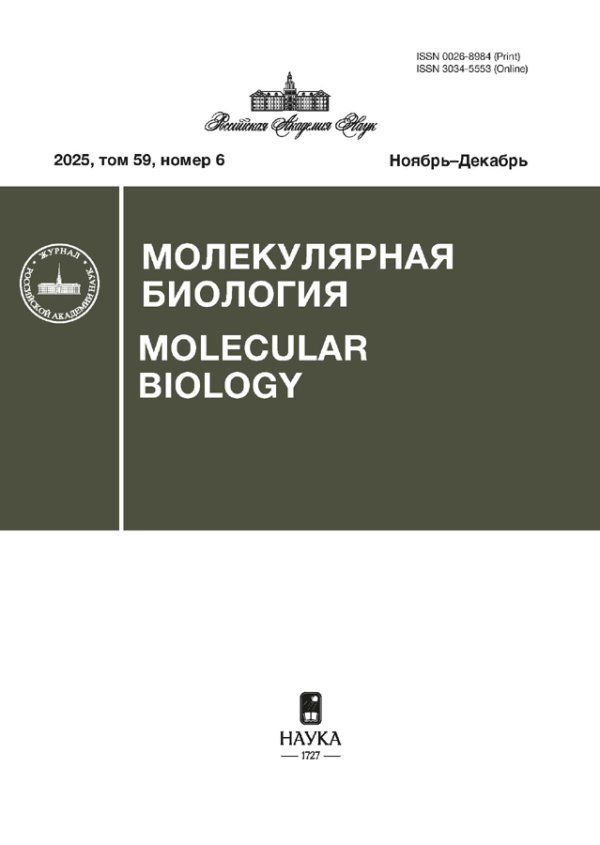Molecular Biology
ISSN (print): 0026-8984
Media registration certificate: No. 0110239 dated 02/08/1993
Founder: Russian Academy of Sciences
Editor-in-Chief Makarov Alexander Alexandrovich
Number of issues per year: 6
Indexation: RISC, list of Higher Attestation Commissions, CrossRef, White List (level 3), Scopus
"Molekulârnaâ biologiâ" covers a wide scope of problems related to molecular, cell and computational biology including genomics, proteomics, bioinformatics, molecular virology and immunology, molecular development biology, and molecular evolution. Molecular Biology publishes reviews, mini-reviews, experimental and theoretical works, short communications. Annualy, the journal publishes special issues devoted to most rapidly developing branches of physical-chemical biology and to the most outstanding scientists on the occasion of their anniversary birthdays. The authors of the journal are from Russia and other countries of the World.
"Molekulârnaâ biologiâ" is indexed/abstracted in Science Citation Index Expanded (SciSearch), Journal Citation Reports/Science Edition, SCOPUS, Chemical Abstracts Service (CAS), Google Scholar, EBSCO Discovery Service, CSA, CAB International, Academic OneFile, Academic Search, AGRICOLA, Biological Abstracts, Biological and Agricultural Index, BIOSIS, CAB Abstracts, CSA Environmental Sciences, EMBiology, Expanded Academic, Global Health, Health Reference Center Academic, Highbeam, INIS Atomindex, OCLC, OmniFile, Science Select, SCImago, Summon by ProQuest, Zoological Record, Microbiology Abstracts Section B: Health & Safety Science Abstracts, Virology and AIDS Abstracts.
Current Issue
Vol 59, No 6 (2025)
ОБЗОРЫ
Recombinase-Based Engineering of Plant Genomes in the Era of Genome Editing
Abstract
 873-890
873-890


Gut microbiota in Colorectal Cancer Carcinogenesis: Evolution of Hypotheses
Abstract
 891–908
891–908


Novel Approaches to anti-EGFR Therapy
Abstract
 909-927
909-927


ГЕНОМИКА. ТРАНСКРИПТОМИКА
Personalised Pharmacotherapy with Sertraline in Patients with Anxiety—Depressive Disorder Based on Omics Biomarkers
Abstract
 928-937
928-937


МОЛЕКУЛЯРНАЯ БИОЛОГИЯ КЛЕТКИ
Benzopyran Derivative Improves Synaptic Plasticity, Exploration Interest and Alleviates Amyloidogenesis and Astrogliosis in 5xFAD Mice
Abstract
 938–956
938–956


Effect of the Histone Lysine Methyltransferase G9a Inhibitor on the Lifespan and Radioresistance of Drosophila melanogaster
Abstract
The enzyme lysine methyltransferase G9a is an important regulator of transcription of various genes and cellular processes, but its role in determining aging and radioresistance of an organism has not been well studied. In this work, the effect of UNC0646, a selective G9a inhibitor, on the lifespan of Drosophila melanogaster and its resistance to γ-radiation and paraquat was investigated. UNC0646 at the concentrations of 0.1–100 μM exerted a geroprotective effect on females, causing an increase in the average lifespan by 1.6–13.9% (p < 0.05). At the same time, after consuming this substance for two weeks, a decrease in Drosophila resistance to γ-radiation was observed. The positive effect of the drug on the lifespan of females may be due to the activation of genes of DNA damage response and repair (D-Gadd45, mei-9, spn-B, Ku80) and proteostasis genes (Hsp27, Hsp68, Atg1, Ire1).
 957–970
957–970


The Role of NOX2-Mediated Oxidative Stress in Initiation of Acute Amyloid Toxicity
Abstract
 971–978
971–978


Newcastle Disease Virus Vaccine Strain H as a Potential Oncolytic Agent in Ovarian Cancer Therapy
Abstract
Ovarian cancer remains one of the most lethal malignancies with a five-year survival rate around 20% at III–IV stages, which determines the urgent need to develop new therapeutic approaches. Newcastle disease virus (NDV) demonstrated considerable promise as an oncolytic agent, capable of selectively lysing tumor cells, suppressing the metastatic potential and stimulating anti-tumor immunity. Despite the established therapeutic potential, studies that investigate oncolytic properties of this virus within the context of ovarian cancer remain limited. In this work, we evaluated oncolytic activity of the NDV vaccine strain H in SC-OV-3, TOV-21G and OV-90 ovarian cancer cell lines. Such parameters as ability to support viral replication and cell viability after infection were investigated. As a result, all three lines were permissive to NDV-H infection. Therapeutic efficacy in vivo was assessed using a model of TOV-21G subcutaneous xenografts in BALB/c nude mice. Upon intravenous administration of the virus, a statistically significant reduction in tumor volume was observed compared to the control group. Based on these results, NDV-H strain can be considered as a potential oncolytic agent for the treatment of ovarian cancer.
 979–987
979–987


Molecular and Genetic Analysis of a Rare Primary Culture of Head and Neck Paraganglioma
Abstract
 988–1001
988–1001


МЕТОДЫ
Comparative Evaluation of DNA Extraction Methods from Fecal Samples: Statistical Analysis of Commercial Kits and Laboratory Protocols Using Real-Time PCR Data
Abstract
Emergence of new data on the association between composition of the intestinal microbiota and various human diseases have generated increasing interest in its investigation. In this context, selection of the DNA extraction method represents a critical stage in experimental design, significantly affecting the reliability and reproducibility of results. This study presents a comparative analysis of 12 DNA extraction methods applied to 46 fecal samples, including 9 commercial kits and 3 laboratory protocols. We evaluated taxonomic representation, including Gram-positive (Lactobacillaceae, Coprococcus spp., Streptococcus sp., Clostridium leptum) and Gram-negative bacteria (Enterobacteriaceae, Akkermansia muciniphila, Fusobacterium nucleatum, Bacteroides fragilis). Extraction efficiency was assessed by DNA yield, expressed in GE/μL of eluate or in GE/g of feces, as well as by the frequency of low-abundance taxa loss. Based on the lysis type, clustering of methods was demonstrated: mechanical lysis provided stable and high DNA yields, particularly for Gram-positive bacteria, while chemical and enzymatic methods showed lower efficiency. We determined that lysis type and preliminary whole-fecal sample preparation are the key factors affecting DNA extraction efficiency and preservation of the native taxonomic profile. The best results were demonstrated by the QIAamp® PowerFecal® Pro DNA Kit (Qiagen) and the combination of AmpliTest UniProb + AmpliTest RIBO-prep kits (Centre for Strategic Planning, of the Federal medical and biological agency, Russia), both of which outperformed other methods in terms of DNA yield. The QIAamp® Fast DNA Stool Mini Kit (Qiagen) showed minimal losses of low-abundance taxa. These findings can be used for the standardization of extraction methodologies and the development of domestic protocols.
 1002-1021
1002-1021


Simultaneous Incorporation of Different Cy5-Labeled Deoxypyrimidine Nucleotides into the Synthesized DNA Chain
Abstract
 1022-1028
1022-1028












